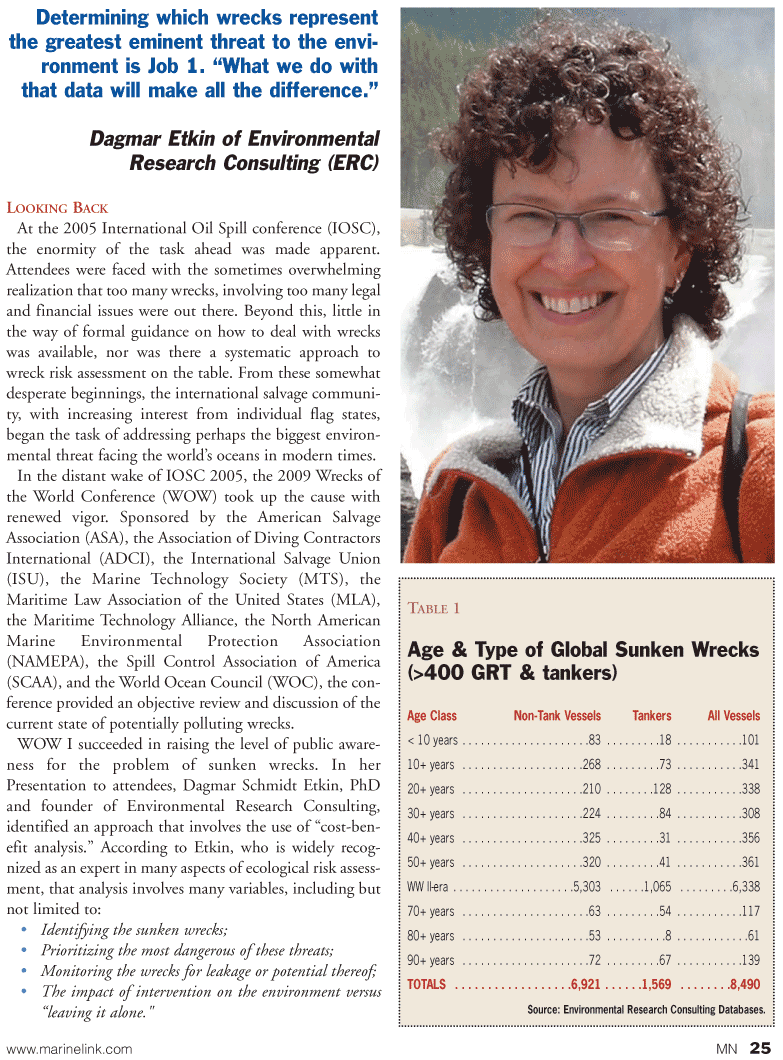
Page 25: of Marine News Magazine (August 2011)
Marine Salvage & Recovery Edition
Read this page in Pdf, Flash or Html5 edition of August 2011 Marine News Magazine
www.marinelink.com MN25Determining which wrecks represent the greatest eminent threat to the envi- ronment is Job 1. What we do with that data will make all the difference.? Dagmar Etkin of EnvironmentalResearch Consulting (ERC) LOOKINGBACK At the 2005 International Oil Spill conference (IOSC), the enormity of the task ahead was made apparent. Attendees were faced with the sometimes overwhelming realization that too many wrecks, involving too many legal and financial issues were out there. Beyond this, little in the way of formal guidance on how to deal with wrecks was available, nor was there a systematic approach to wreck risk assessment on the table. From these somewhat desperate beginnings, the international salvage communi- ty, with increasing interest from individual flag states, began the task of addressing perhaps the biggest environ- mental threat facing the worlds oceans in modern times. In the distant wake of IOSC 2005, the 2009 Wrecks of the World Conference (WOW) took up the cause with renewed vigor. Sponsored by the American Salvage Association (ASA), the Association of Diving Contractors International (ADCI), the International Salvage Union (ISU), the Marine Technology Society (MTS), the Maritime Law Association of the United States (MLA), the Maritime Technology Alliance, the North American Marine Environmental Protection Association (NAMEPA), the Spill Control Association of America (SCAA), and the World Ocean Council (WOC), the con- ference provided an objective review and discussion of the current state of potentially polluting wrecks. WOW I succeeded in raising the level of public aware- ness for the problem of sunken wrecks. In her Presentation to attendees, Dagmar Schmidt Etkin, PhD and founder of Environmental Research Consulting, identified an approach that involves the use of cost-ben- efit analysis.? According to Etkin, who is widely recog- nized as an expert in many aspects of ecological risk assess- ment, that analysis involves many variables, including but not limited to:?Identifying the sunken wrecks; ?Prioritizing the most dangerous of these threats; ?Monitoring the wrecks for leakage or potential thereof; ?The impact of intervention on the environment versus leaving it alone."TABLE1Age & Type of Global Sunken Wrecks (>400 GRT & tankers) Age ClassNon-Tank VesselsTankersAll Vessels < 10 years . . . . . . . . . . . . . . . . . . . . .83 . . . . . . . . .18 . . . . . . . . . . .101 10+ years . . . . . . . . . . . . . . . . . . . .268 . . . . . . . . .73 . . . . . . . . . . .341 20+ years . . . . . . . . . . . . . . . . . . . .210 . . . . . . . .128 . . . . . . . . . . .338 30+ years . . . . . . . . . . . . . . . . . . . .224 . . . . . . . . .84 . . . . . . . . . . .308 40+ years . . . . . . . . . . . . . . . . . . . .325 . . . . . . . . .31 . . . . . . . . . . .356 50+ years . . . . . . . . . . . . . . . . . . . .320 . . . . . . . . .41 . . . . . . . . . . .361 WW ll-era . . . . . . . . . . . . . . . . . . . .5,303 . . . . . .1,065 . . . . . . . . .6,338 70+ years . . . . . . . . . . . . . . . . . . . . .63 . . . . . . . . .54 . . . . . . . . . . .117 80+ years . . . . . . . . . . . . . . . . . . . . .53 . . . . . . . . . .8 . . . . . . . . . . . .61 90+ years . . . . . . . . . . . . . . . . . . . . .72 . . . . . . . . .67 . . . . . . . . . . .139 TOTALS . . . . . . . . . . . . . . . . . .6,921 . . . . . .1,569 . . . . . . . .8,490 Source: Environmental Research Consulting Databases.

 24
24

 26
26
